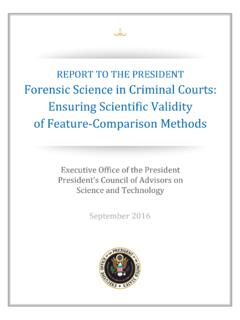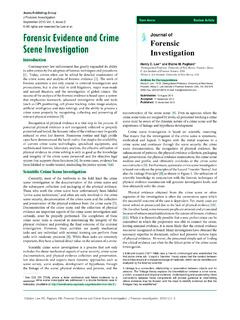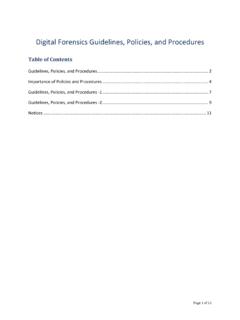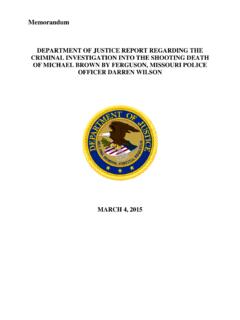Transcription of Crime Scene Investigation
1 Department of JusticeOffice of Justice ProgramsNational Institute of Justiceresearch reportA Guide for Law EnforcementA Guide for Law EnforcementCrime SceneInvestigationCrime Department of JusticeOffice of Justice Programs810 Seventh Street , DC 20531 Janet RenoAttorney GeneralDaniel MarcusActing Associate Attorney GeneralLaurie RobinsonAssistant Attorney GeneralNo l BrennanDeputy Assistant Attorney GeneralJeremy TravisDirector, National Institute of JusticeDepartment of Justice Response Center800 421 6770 Office of Justice ProgramsNational Institute of JusticeWorld Wide Web SiteWorld Wide Web photograph of man on the ground by Corbis Images. Other cover photographscopyright 1999 PhotoDisc, and Approved by theTechnical Working Group on Crime Scene InvestigationJanuary 2000A Guide for Law EnforcementCrime Scene Department of JusticeOffice of Justice ProgramsNational Institute of JusticeJeremy Travis, M.
2 Rau, MonitorOpinions or points of view expressed in this document are a consensus ofthe authors and do not necessarily reflect the official position of the of 178280 The National Institute of Justice is a component of the Office of Jus-tice Programs, which also includes the Bureau of Justice Assistance,the Bureau of Justice Statistics, the Office of Juvenile Justice andDelinquency Prevention, and the Office for Victims of From the Attorney GeneralActions taken at the outset of an Investigation at a Crime Scene canplay a pivotal role in the resolution of a case. Careful, thoroughinvestigation is key to ensure that potential physical evidence is nottainted or destroyed or potential witnesses many agencies have programs in Crime Scene processing, the levelof training and resources available varies from jurisdiction to jurisdiction,as does the opportunity to practice actual Investigation .
3 To help theseagencies, the National Institute of Justice supported the development ofthis commend the hard work of the 44 members of the technical workinggroup that created this guide. They are representative of law enforcement,the prosecution, the defense, and forensic science, and their collectiveexpert knowledge, experience, and dedication to the task made this efforta guide is one method of promoting quality Crime Scene type and scope of a Crime Scene Investigation will vary from case tocase. Jurisdictions will want to carefully consider the procedures in thisguide and their applicability to local agencies and RenoAttorney GeneralvTechnical Working Group on Crime Scene InvestigationThe Technical Working Group on Crime Scene Investigation (TWGCSI) is a multidisciplinary group of content-area expertsfrom across the United States, from both urban and rural jurisdictions,each representing his or her respective agency or practice.
4 Each of theseindividuals is experienced in the area of Crime Scene Investigation andevidence collection in the criminal justice system from the standpoints oflaw enforcement, prosecution, defense, or forensic the outset of the TWGCSI effort, the National Institute of Justice(NIJ) created a planning panel composed of distinguished law enforce-ment, legal, and science professionals to define needs, to develop initialstrategies, and to steer the larger group. Additional members of thetechnical working group were then selected from recommendationssolicited from the planning panel, NIJ s regional National Law Enforce-ment and Corrections Technology Centers, and national organizationsincluding the American Academy of forensic Science, National DistrictAttorneys Association, National Association of criminal Defense Law-yers, National Legal Aid and Defender Association, International Asso-ciation of Chiefs of Police, National Sheriffs Association, InternationalAssociation for Identification, and the American Association of CrimeLaboratory Directors/Laboratory Accreditation , over a 1-year period, the 44 members of TWGCSI listedbelow worked together to develop this guide, Crime Scene Investigation :A Guide for Law Crime Scene Planning Panel (NCSPP)Dr.
5 Jose R. AlmirallAssociate Director andAssistant ProfessorInternational forensic ResearchInstituteDepartment of ChemistryFlorida International UniversityMiami, FloridaSusan BallouForensic ScientistMontgomery County PoliceDepartmentCrime LaboratoryRockville, MarylandPaul CarrollSergeant (Ret.)Chicago Police DepartmentBig Pine Key, FloridaviElizabeth FarrisChief Trial CounselHampden County DistrictAttorney s OfficeSpringfield, MassachusettsJo Ann GivenASCLD/LABN aval criminal InvestigativeServiceNorfolk, VirginiaMarjorie HarrisForensic Scientist, SeniorDepartment of criminal JusticeDivision of forensic ScienceRichmond, VirginiaHal R. ArensteinAttorney at LawLaw Offices of Hal ArensteinCincinnati, OhioDexter J. BartlettInspectorIllinois State PoliceCrime Scene Services CommandJoliet, IllinoisEric BuelDirectorDepartment of Public SafetyCrime LaboratoryWaterbury, VermontJeff CoverSupervisor, Crime Scene UnitAnne Arundel County PoliceDepartmentMillersville, MarylandElizabeth DevineSupervising CriminalistScientific Services BureauLos Angeles County Sheriff sDepartmentLos Angeles, CaliforniaHenry EscobarDetectiveSan Antonio Police DepartmentSan Antonio, TexasJerry N.
6 EstesDistrict Attorney General10th Judicial DistrictAthens, TennesseeLarry McCannSenior Special Agent (Ret.)Virginia State PoliceRichmond, VirginiaDr. Joseph L. PetersonDepartment of criminal JusticeUniversity of IllinoisChicago, IllinoisElliot B. SpectorDirectorCenter for Police and SecurityTrainingSuffield, ConnecticutAnn TalbotASCLD/LABA lbuquerque Police DepartmentAlbuquerque, New MexicoJames T. Tom ThurmanAssociate ProfessorCollege of Law EnforcementEastern Kentucky UniversityRichmond, KentuckyAdditional Technical Working Group MembersJames EstradaDetective InvestigatorHomicide UnitSan Antonio Police DepartmentSan Antonio, TexasDrew FindlingAttorneyAtlanta, GeorgiaNan Horvat/John SarconeAssistant Polk County Attorney/Polk County AttorneyDes Moines, IowaN. Michael HurleyRegional DirectorOregon State PoliceForensic Services DivisionSpringfield, OregonGary L.
7 KaldunForensic Scientist, CrimeScene CoordinatorBureau of criminal ApprehensionSt. Paul, MinnesotaJoe MarchanSupervising CriminalistTexas Department of PublicSafety Crime LaboratoryMcAllen, TexasJoseph John Moseley, IIDetectiveCentral Homicide EvaluationSupport SquadChicago Police DepartmentChicago, IllinoisRobert MullinsDetectiveInvestigative ServicesNew Haven Police DepartmentNew Haven, ConnecticutSteve NashDetectiveMarin County Sheriff sDepartmentSan Rafael, CaliforniaKathryn Normington-HollenbachSenior forensic ScientistWyoming State CrimeLaboratoryCheyenne, WyomingGalen PaineAssistant Public DefenderPublic Defender s OfficeSitka, AlaskaMichael J. RaffertyChief of ForensicsFlorida Department of LawEnforcementFort Myers Regional OperationsCenterFort Myers, FloridaEugene RifenburgSenior Investigator (Ret.)New York State PoliceInvestigator (current)Oneida Nation PoliceMunnsville, New YorkviiGary A.
8 RiniPolice Commander (Ret.)DirectorThe American Institute forPolice ScienceElkhorn, NebraskaHeidi RobbinsSupervising CriminalistScientific Services BureauLos Angeles County Sheriff sDepartmentLos Angeles, CaliforniaDarrell RyanLieutenantNashville Police DepartmentNashville, TennesseeNorman ShapiroVice President, New YorkState Defender s AssociationCounselor at LawLaw Offices of Norman ShapiroMiddletown, New YorkClarene ShelleyLieutenantLakewood Police DepartmentLakewood, ColoradoGregory SmithAssistant County ProsecutorOffice of the County ProsecutorCamden CountyCamden, New JerseyRichard StanekCaptainMinneapolis Police DepartmentMinneapolis, MinnesotaBrad TownsendSergeantCorona Police DepartmentCorona, CaliforniaLarry TurnerDirector of forensic ServicesJackson Police DepartmentCrime LaboratoryJackson, MississippiStephen WeichmanCounty and ProsecutingAttorneyTeton CountyJackson, WyomingJames WiserCrime Scene Investigator/Evidence CustodianMount Pleasant PoliceDepartmentMount Pleasant, South CarolinaLarry WoodDetectiveMajor Case UnitSmyrna Police DepartmentSmyrna, GeorgiaJohn YarbroughSergeantHomicide BureauLos Angeles County Sheriff sDepartmentCommerce, CaliforniaixAcknowledgmentsThe National Institute of Justice (NIJ) wishes to thank the TechnicalWorking Group on Crime Scene Investigation (TWGCSI) for theirdedication and endurance.
9 This 44-member network of experts from avariety of backgrounds gave their time to draft and review the guide,providing feedback from all areas of the Nation. The true strength ofthis document is derived from the commitment of the TWG membersto produce a guide that could be implemented across the country, fromsmall, rural townships to large, metropolitan areas. In addition, theagencies and organizations that employ each member of the group sharein this endeavor. Through their support, each member was given theflexibility needed to complete the also wishes to thank Attorney General Janet Reno, whose supportand commitment to the improvement of the criminal justice system madethis work possible. In addition, appreciation is extended to David , Director of NIJ s Office of Science and Technology, and toRichard M. Rau, , the NIJ Project Monitor, for his unwaveringsupport of, and guidance through, the process and production of would like to thank all the individuals from various national organi-zations who responded to the request for nominations of experts with awide expanse of knowledge and experience in the field of Crime sceneinvestigation.
10 It was from their recommendations that the members wereselected. In particular, thanks to Jim Polley from the National DistrictAttorneys Association, Dan Rosenblatt from the International Associa-tion of Chiefs of Police, Stuart Statler from the National Association ofCriminal Defense Lawyers, Clinton Lyons from the National Legal Aidand Defender Association, Aldine N. Bubby Moser, Jr., from theNational Sheriffs Association, and Ronald C. Jackson from the Interna-tional Association for Identification. NIJ would also like to thank MikeGrossman, Director of NIJ s Technology Assistance Division, for hisnominations of law enforcement candidates and his help in obtainingxrecommendations from NIJ s regional National Law Enforcement andCorrections Technology Centers (NLECTC), as well as the directors ofthose centers: James A. Keller, Robert Pentz, Chris Aldridge, John Ritz,Thomas Sexton, and Tom Burgoyne.







